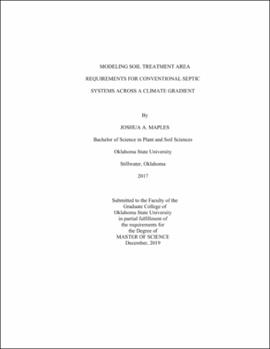| dc.contributor.advisor | Abit, Sergio | |
| dc.contributor.author | Maples, Joshua A. | |
| dc.date.accessioned | 2020-06-29T17:39:10Z | |
| dc.date.available | 2020-06-29T17:39:10Z | |
| dc.date.issued | 2019-12 | |
| dc.identifier.uri | https://hdl.handle.net/11244/324897 | |
| dc.description.abstract | Roughly 19% of homes in the U.S. use onsite wastewater treatment systems (OWTS) for the treatment and dispersal of domestic wastewater. In Oklahoma, upwards of 40% of single-family homes rely on OWTS for effluent removal. The most common type of OWTS is the conventional septic system. A conventional septic system is comprised of two main parts: the septic tank and the soil treatment area. This study focused on assessing the appropriateness of current regulations for the sizing of conventional septic systems across a large climate gradient. This study aims to evaluate the effects of potential reductions in soil treatment area (STA) sizes for different soil groups under various precipitation regimes across Oklahoma's climate divisions. Subsurface water flow was simulated for conventional septic systems of five different STA sizes in each of three different soil types in each of nine climate divisions using the one-dimensional hydrologic model, HYDRUS-1D. The simulated matric potential directly beneath the bottom of the trench was used to indicate viable sizing requirements. If the matric potential reached zero or above, it would indicate ponding or potential septic system backflow. Results suggest current sizing requirements are viable, and reductions in STA across the climate gradient may be possible, depending on the acceptable failure rate. It can be concluded that precipitation variability from a climate gradient directly impacts the hydraulic performance of the STA sizes. Recommendations for reductions of conventional OWTS sizes are feasible up to at least 40% in some regions across soil types. | |
| dc.format | application/pdf | |
| dc.language | en_US | |
| dc.rights | Copyright is held by the author who has granted the Oklahoma State University Library the non-exclusive right to share this material in its institutional repository. Contact Digital Library Services at lib-dls@okstate.edu or 405-744-9161 for the permission policy on the use, reproduction or distribution of this material. | |
| dc.title | Modeling soil treatment area requirements for conventional septic systems across a climate gradient | |
| dc.contributor.committeeMember | Ochsner, Tyson | |
| dc.contributor.committeeMember | Ferrell, Shannon | |
| osu.filename | Maples_okstate_0664M_16538.pdf | |
| osu.accesstype | Open Access | |
| dc.type.genre | Thesis | |
| dc.type.material | Text | |
| dc.subject.keywords | climate gradient | |
| dc.subject.keywords | effluent | |
| dc.subject.keywords | hydrus-1d | |
| dc.subject.keywords | septic system | |
| dc.subject.keywords | soil treatment area | |
| dc.subject.keywords | wastewater | |
| thesis.degree.discipline | Plant and Soil Sciences | |
| thesis.degree.grantor | Oklahoma State University | |
